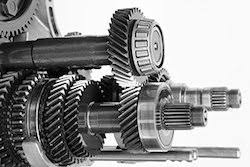Introduction
Gearbox assemblies are the backbone of countless mechanical systems, enabling efficient power transmission and control. These assemblies act as intermediaries between power sources, such as engines or motors, and the devices they drive, adapting speed and torque to meet specific operational demands. Whether in vehicles, industrial machinery, or precision robotics, gearbox assemblies ensure that machines operate smoothly, efficiently, and reliably under varying loads and conditions. Their versatility and critical functionality make them a cornerstone of modern engineering, driving advancements in industries ranging from automotive and aerospace to energy and manufacturing.
Key Functions
- Speed Regulation
- Gearbox assemblies modify the rotational speed of the input shaft to suit specific applications. For example, in automobiles, the gearbox adjusts the engine’s speed to deliver optimal performance in varying driving conditions, such as low-speed crawling or high-speed cruising.
- Torque Transmission
- Torque refers to the rotational force needed to drive a load. Gearboxes increase torque by reducing speed through gear reduction, ensuring machinery can handle heavy loads without overstraining the motor or engine.
- Direction Control
- Some gearbox assemblies enable changes in the rotational direction of the output shaft. This is particularly useful in automotive reverse gears or machinery requiring bidirectional operation.
- Power Distribution
- In complex systems, such as tractors or multi-axle vehicles, gearbox assemblies distribute power to multiple outputs. This ensures each component receives the necessary torque and speed for its function.
- Efficiency Improvement
- By optimizing gear ratios, gearbox assemblies minimize energy losses during transmission. This leads to better fuel efficiency in vehicles and reduced operational costs in industrial settings.
Types of Gearbox Assemblies
- Manual Gearboxes
- Operated manually by shifting gears using a clutch. These are commonly found in older vehicles and machines requiring operator control for precise operation.
- Automatic Gearboxes
- Automatically adjust gear ratios based on speed and load without user intervention. Widely used in modern vehicles for convenience and ease of driving.
- Planetary Gearboxes
- Compact systems with high torque capabilities, consisting of sun, planet, and ring gears. Commonly used in automatic transmissions and heavy machinery.
- Worm Gearboxes
- Feature a worm gear and worm wheel, transmitting power at a 90-degree angle. Known for their high torque output and self-locking properties.
- Helical Gearboxes
- Use helical gears for smooth and quiet operation. Suitable for heavy-duty applications, such as conveyors and cranes.
- Bevel Gearboxes
- Designed for applications requiring input and output shafts to operate at an angle, typically 90 degrees. Common in differential systems of vehicles.
Components of a Gearbox Assembly
- Gears
- The core elements responsible for altering speed and torque. Types include spur gears (simple, straight teeth), helical gears (angled teeth for smooth operation), bevel gears (angled operation), and worm gears (self-locking and high-torque).
- Shafts
- Support and transmit motion between gears. Input shafts connect to the power source, while output shafts transfer energy to the machinery.
- Bearings
- Reduce friction between rotating components, ensuring smooth motion and preventing premature wear.
- Housing
- Encases the gearbox components, protecting them from dust, moisture, and mechanical damage. It also supports proper alignment.
- Seals
- Prevent oil leakage and keep contaminants out, ensuring long-term operational efficiency.
- Lubrication System
- Reduces friction and heat, extending the life of gears and bearings. Includes oil reservoirs or grease fittings for regular maintenance.
Applications of Gearbox Assemblies
- Automotive Industry
- Gearboxes manage speed and torque for smooth driving in cars, trucks, and buses, enabling efficient performance under various conditions.
- Aerospace
- Found in aircraft engines and control systems, where precise speed and torque adjustments are critical for safety and efficiency.
- Industrial Machinery
- Used in conveyors, mixers, crushers, and other heavy equipment, ensuring reliable and powerful operation in demanding environments.
- Robotics
- Enable precise motion control in robotic arms, ensuring accurate positioning and efficient power transmission.
- Wind Turbines
- Adjust the rotor’s slow rotational speed to the high-speed requirements of generators for optimal electricity generation.
- Marine Applications
- Provide power to propellers, ensuring smooth and reliable operation of vessels in harsh conditions.
Maintenance Tips for Gearbox Assemblies
- Regular Inspection
- Periodically check for signs of wear, misalignment, or damage in gears, shafts, and bearings to prevent unexpected breakdowns.
- Lubrication
- Maintain appropriate oil levels and replace worn-out lubricants to ensure smooth operation and reduce friction.
- Seal and Housing Care
- Inspect seals for leaks and clean the housing to prevent contamination from external elements like dust or moisture.
- Temperature Monitoring
- Overheating can damage gearbox components. Regularly monitor operating temperatures and address any abnormalities.
- Alignment Checks
- Proper alignment prevents uneven wear and reduces the risk of component failure, ensuring long-term performance.
Advantages of Gearbox Assemblies
- Versatility
- Cater to a wide range of speed and torque requirements, making them suitable for diverse applications.
- Durability
- Designed to withstand heavy loads and harsh conditions, offering long-lasting performance.
- Precision
- Provide accurate control over mechanical power for sensitive applications like robotics or aerospace systems.
- Efficiency
- Reduce power losses by optimizing energy transmission, leading to cost savings and improved operational efficiency.
- Compact Design
- Available in space-saving configurations, ideal for applications with limited installation space.
Conclusion
In conclusion, gearbox assemblies are an essential component of modern machinery, providing a robust and reliable solution for managing power, speed, and torque. Their adaptability to a wide range of applications highlights their importance in diverse fields, from everyday vehicles to cutting-edge robotic systems and renewable energy technologies. By carefully selecting the right type of gearbox for specific needs and adhering to proper maintenance practices, organizations can optimize performance, extend equipment lifespan, and reduce operational costs. Gearbox assemblies not only ensure the seamless functioning of mechanical systems but also exemplify engineering ingenuity, continuing to evolve with advancements in materials and design to meet the demands of a rapidly changing world.

